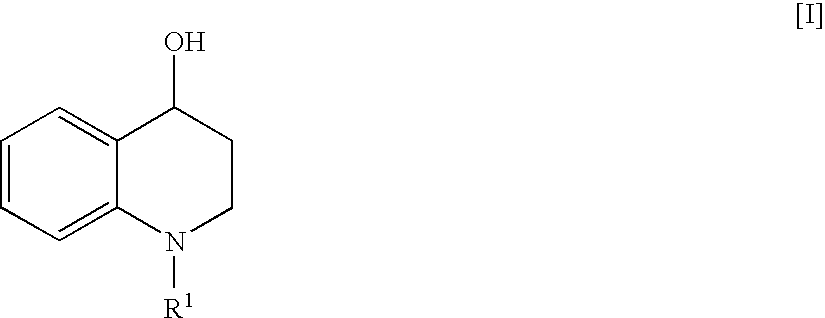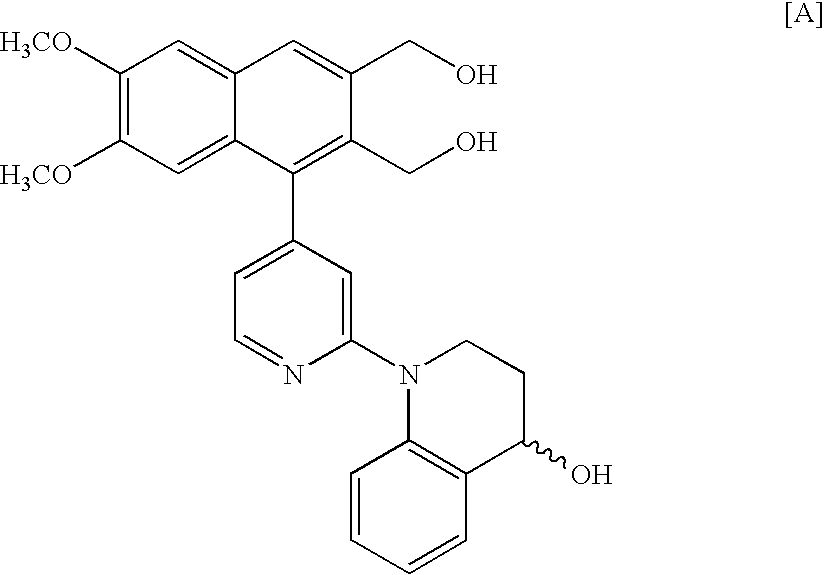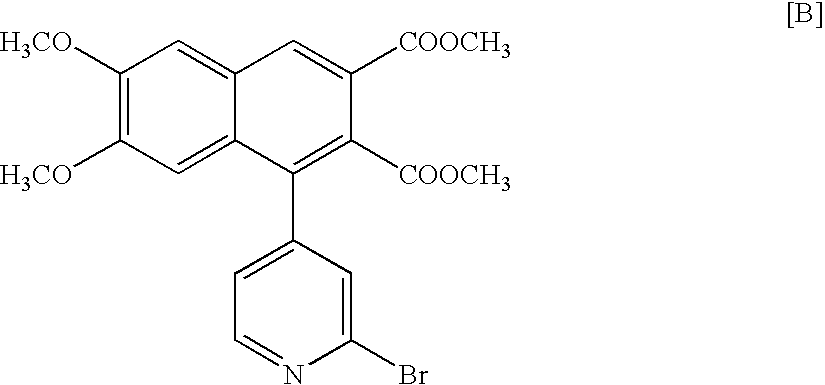Method of enzymatic optical resolution of racemic 4-hydroxy-1,2,3,4-tetrahydroquinoline
a technology of enzymatic optical resolution and quinoline, which is applied in the field of preparing an optically active 4hydroxy1, 2, 3, 4tetrahydroquinoline compound, and achieves the effect of high optical purity and good yield
- Summary
- Abstract
- Description
- Claims
- Application Information
AI Technical Summary
Benefits of technology
Problems solved by technology
Method used
Image
Examples
example 1
[0076]About 10 mg of enzyme shown in the following Table 1 was weighed into a test tube. At the same time, 4 mg of racemic 1-benzyloxycarbonyl-4-hydroxy-1,2,3,4-tetrahydroquinoline and 6 mg of vinyl acetate were dissolved in 1 mL of tert-butylmethylether. The solution was added to the test tube wherein the enzyme has been weighed in advance, and the test tube was shaken at 30° C. for about 20 hours. The reaction solution was centrifuged, and the supernatant was sampled and subjected to HPLC analysis.
[0077]HPLC measurement condition
[0078]Column: CHIRALPAK AD-H (4.6×250 mm)
[0079]Mobile phase: n-hexane / ethanol=10:1
[0080]Column temperature: 40° C.
[0081]Flow rate: 11.0 mL / min
[0082]Detection wavelength: 254 nm
[0083]Retention times of the (S)-4-hydroxy compound, the (R)-4-hydroxy compound and the 4-acetoxy compound were 19.6 minute, 26.8 minute, and 9.4 minute, respectively.
[0084]The results are shown in Table 1. Conversion ratio (%) means a ratio that the 4-hydroxy compound has been conve...
example 2
[0086]A racemic 4-hydroxy-1-tert-butoxycarbonyl-1,2,3,4-tetrahydroquinoline was used as a substrate, and was reacted with the enzymes shown in the following Table 2 in the same manner as Example 1. Results are shown in the following Table 2.
[0087]
TABLE 2ConversionOptical purityEnzyme nameratio (%)(% ee)Lipase PL55.585.4[derived from Alcaligenes sp.,manufactured by Meito Sangyo Co., Ltd.]LPL74.1100.0[derived from Pseudomonas sp.,manufactured by TOYOBO CO., LTD.]CHIRAZYME L-241.576.0[derived from Candida antarctica,manufactured by Roche Diagnostics K.K.]CHIRAZYME L-957.8100.0[derived from Candida antarctica,manufactured by Roche Diagnostics K.K.]Lipase PS46.376.8[derived from Burtholderia cepacia,manufactured by Amano Enzyme Inc.]Lipase AH49.6100.0[derived from Burkholderia cepacia,manufactured by Amano Enzyme Inc.]
example 3
[0088]Reaction was conducted in the same manner as Example 1 using the enzyme shown in the following Table 3. Results are shown in the following Table 3. Incidentally, optical purity (% ee) means enantiomeric excess of the (R)-4-hydroxy compound.
[0089]
TABLE 3ConversionOptical purityEnzyme nameratio (%)(% ee)CHIRAZYME L-573.294.5[derived from Candida antarctica,manufactured by Roche Diagnostics K.K.]
PUM
| Property | Measurement | Unit |
|---|---|---|
| temperature | aaaaa | aaaaa |
| temperature | aaaaa | aaaaa |
| Reaction temperature | aaaaa | aaaaa |
Abstract
Description
Claims
Application Information
 Login to View More
Login to View More - R&D
- Intellectual Property
- Life Sciences
- Materials
- Tech Scout
- Unparalleled Data Quality
- Higher Quality Content
- 60% Fewer Hallucinations
Browse by: Latest US Patents, China's latest patents, Technical Efficacy Thesaurus, Application Domain, Technology Topic, Popular Technical Reports.
© 2025 PatSnap. All rights reserved.Legal|Privacy policy|Modern Slavery Act Transparency Statement|Sitemap|About US| Contact US: help@patsnap.com



